We’ve all dreamed of transforming our outdoor spaces into lush green sanctuaries that climb skyward and create natural privacy screens. Vine plants for outdoor climbing offer the perfect solution for maximizing vertical growing space while adding stunning visual appeal to any industry.
Whether you’re looking to cover an unsightly fence or create a living wall that blooms with seasonal color, climbing vines deliver impressive results with minimal ground space requirements. These versatile plants can transform boring walls into breathtaking green backdrops and provide natural cooling for your home during hot summer months.
From fast-growing annual vines that provide instant gratification to perennial climbers that develop into stunning permanent features, we’ll explore the best options for your exact growing conditions and design goals. Let’s jump into the industry of climbing vines and discover how these remarkable plants can elevate your outdoor space to new heights.
Choose Fast-Growing Annual Vines for Quick Coverage
Annual vines offer the perfect solution when you need immediate vertical coverage for your outdoor climbing spaces. These vigorous growers can transform bare walls and empty trellises in just one growing season.
Morning Glory for Rapid Vertical Growth
Morning glories deliver spectacular climbing performance with their heart shaped leaves and trumpet flowers that open each dawn. We’ve watched these vines reach heights of 6 to 10 feet in a single season while producing blooms in purple, blue, pink, and white varieties. Their twining stems naturally spiral around supports like trellises, arbors, and fence posts without requiring additional ties or training.
Seeds germinate quickly in warm soil and establish vigorous root systems that fuel rapid upward growth throughout summer months. These hardy annuals thrive in full sun locations and tolerate various soil conditions from sandy to clay compositions. Morning glory vines create dense coverage that effectively screens unsightly areas while their daily blooming cycle adds ever-changing visual interest to vertical garden spaces.
Sweet Peas for Fragrant Climbing Beauty
Sweet pea vines combine delicate climbing ability with intensely fragrant flowers that perfume entire garden areas. We recommend these cool season annuals for spring and early summer coverage since they prefer temperatures between 55 and 65 degrees Fahrenheit. Their tendrils grasp onto wire supports, bamboo poles, and mesh structures while reaching heights of 4 to 8 feet depending on variety selection.
Flowers appear in soft pastel shades including pink, purple, white, and salmon colors that create romantic garden atmospheres. Sweet peas produce continuous blooms when regularly harvested for indoor bouquets, encouraging extended flowering periods throughout their growing season. These climbing beauties establish quickly from direct seeded plantings in early spring and provide excellent coverage for shorter structures like garden borders and low fences.
Nasturtiums for Edible Climbing Options
Nasturtium vines offer unique dual purpose functionality as both ornamental climbers and edible garden additions. We’ve discovered that climbing varieties like ‘Tall Mixed’ and ‘Canary Bird’ reach 6 to 8 feet while producing vibrant orange, yellow, and red flowers with distinctive peppery flavors. Their round shield shaped leaves also provide edible options with watercress like taste profiles that enhance salads and garnish plates.
These versatile vines thrive in poor soil conditions and actually produce more flowers when grown in nutrient deficient locations rather than rich garden beds. Nasturtiums climb using twisting leaf stems that wrap around thin supports such as string, wire, and small diameter poles. Their fast establishment and continuous blooming make them excellent choices for covering temporary structures, filling gaps in existing climbing displays, and adding instant color to vertical garden spaces.
Select Perennial Climbing Vines for Long-Term Investment
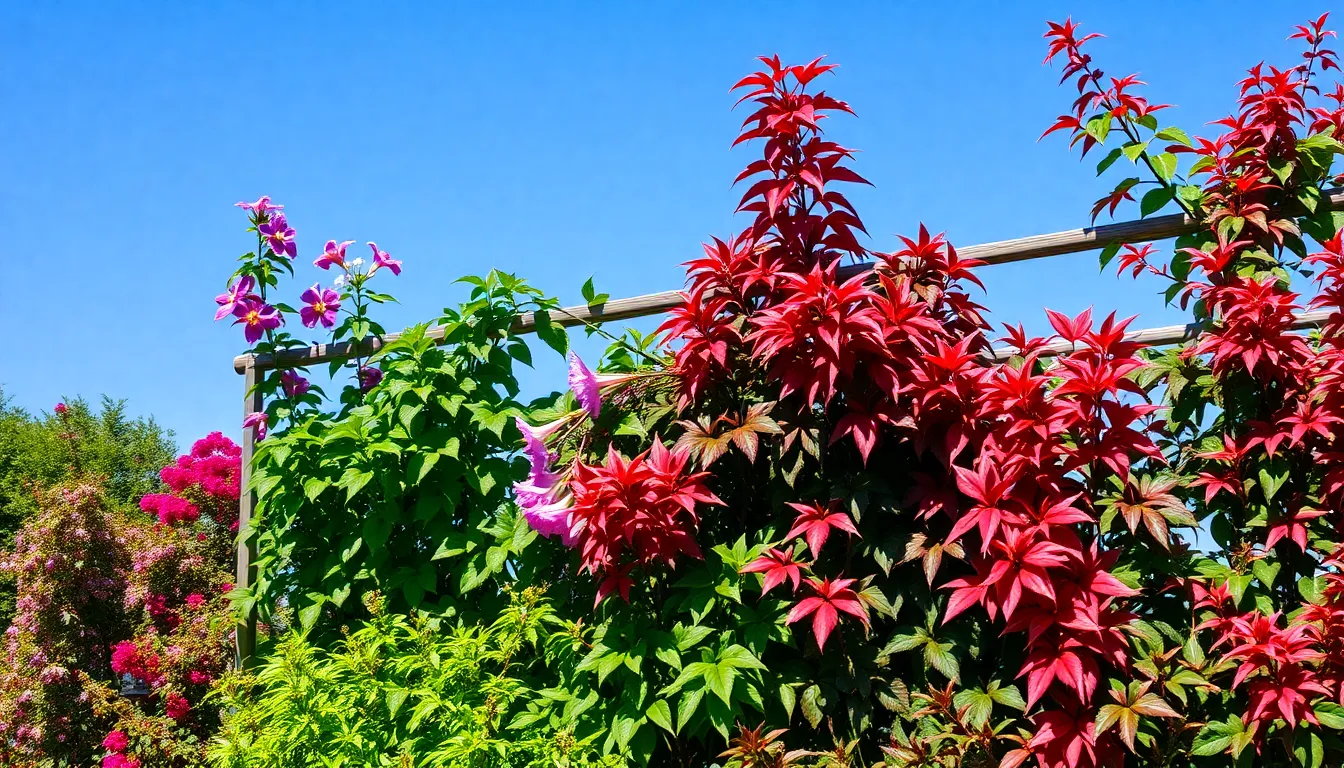
Perennial climbing vines offer exceptional value by returning year after year, gradually increasing coverage and beauty while providing privacy and shade. We recommend these hardy options that establish deep root systems and deliver lasting performance across multiple growing seasons.
Clematis for Stunning Flowering Displays
Clematis delivers spectacular blooms with approximately 300 species available in climbing forms, making it one of our most versatile recommendations. Popular garden varieties like ‘Jackmanii,’ ‘Nelly Moser,’ and sweet autumn clematis produce large flowers in white, pink, purple, and red throughout their blooming seasons.
These vines reach 3 to 15 feet in length and require full sun to partial shade with medium moisture, well-drained soils. Support structures like trellises become essential as clematis spreads widely and needs guidance for proper upward growth. Most varieties are deciduous, so we suggest planning your design around seasonal leaf loss for year-round garden appeal.
Honeysuckle for Fragrant Evening Blooms
Honeysuckle vines excel at creating sweetly fragrant evening displays that attract hummingbirds and moths to your outdoor space. Dense foliage coverage makes these vigorous climbers perfect for screening unattractive areas or creating natural privacy barriers in your garden design.
Full sun to partial shade conditions suit honeysuckle best, though they adapt well to various growing situations. Sturdy support structures become necessary due to their fast growth and spreading nature. Evening blooms release the strongest fragrance, making honeysuckle an excellent choice for patios and seating areas where you’ll enjoy their aromatic qualities.
Virginia Creeper for Dense Foliage Coverage
Virginia Creeper (Parthenocissus quinquefolia) provides rapid coverage using small adhesive discs that cling naturally to surfaces without additional support mechanisms. This hardy perennial creates lush, dense foliage that transforms into brilliant red fall color, offering seasonal interest beyond basic coverage.
Tolerance for various soil types and light conditions makes Virginia Creeper extremely adaptable, thriving equally well in full sun or shade environments. Fast growth allows quick coverage of walls, fences, and trellises while maintaining year-round greenery except during natural leaf drop periods. Privacy screens benefit significantly from this vine’s ability to create thick, natural barriers that mature quickly and require minimal maintenance once established.
Install Proper Support Structures for Vine Plants
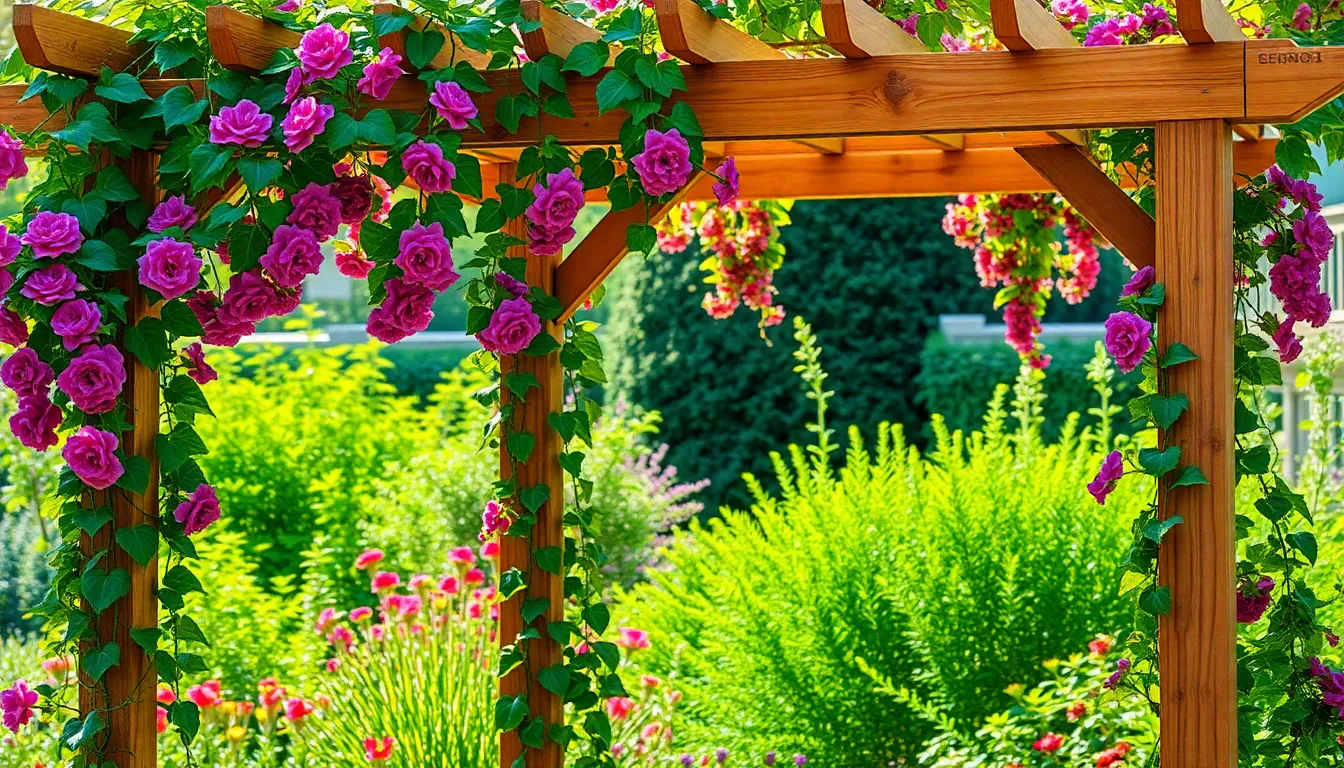
Creating the foundation for successful vine growth requires selecting and installing appropriate support systems that match your plants’ exact climbing habits and growth patterns.
Trellises and Arbors for Decorative Support
Vertical frameworks like trellises transform ordinary walls and garden spaces into stunning focal points. We can install these structures against existing walls or use them as freestanding features to support climbing roses, clematis, and other decorative vines. Trellises serve multiple purposes beyond plant support, functioning as garden dividers and privacy screens that add height and visual interest to outdoor spaces.
Arbors create dramatic entryways and shaded walkways that welcome visitors into garden areas. These arch-shaped structures allow vines to climb overhead, forming natural canopies that provide both beauty and function. We recommend choosing materials like treated wood or powder-coated metal for both trellises and arbors, as these weather-resistant options reliably support perennial vines throughout multiple growing seasons.
Design flexibility makes these decorative supports ideal for creating living architectural elements. Different vine species respond uniquely to vertical supports, with some wrapping around posts while others use tendrils to grip framework openings. Proper spacing between support elements ensures adequate airflow and prevents overcrowding as plants mature.
Wire Mesh and Fencing for Large Coverage Areas
Lightweight wire mesh stretched between sturdy posts provides practical support for spreading vine varieties. This installation method works exceptionally well for peas, beans, and sweet peas that climb using curling tendrils. We can easily cover wide garden areas using this approach, making it cost-effective for extensive vine plantings.
Existing fences and walls become productive growing surfaces when equipped with mesh systems. Garden netting attached to these structures creates instant climbing opportunities without requiring separate framework construction. The mesh should support mature plant weight while allowing easy harvesting access for edible varieties.
Installation requires firm anchoring to withstand wind pressure and growth weight. Posts must be deeply set and properly braced to prevent sagging or collapse as vines reach full size. We recommend checking mesh tension regularly throughout the growing season and making adjustments as needed.
Pergolas and Gazebos for Overhead Climbing
Sturdy overhead structures support heavy vine growth while creating natural shade canopies. Pergolas and gazebos accommodate sprawling varieties like wisteria, jasmine, and bougainvillea that require extensive horizontal support systems. These installations transform ordinary outdoor spaces into inviting retreat areas with living green roofs.
Weatherproof construction materials ensure long-term durability under vine weight and weather exposure. Metal or treated wood frameworks withstand the substantial load of mature climbing plants while maintaining structural integrity. We need robust construction because established vines can become quite heavy over time.
Strategic placement enhances both garden design and functional benefits. Positioning these structures near seating areas creates comfortable shaded spaces during hot summer months. The combination of vertical posts and horizontal beams provides multiple attachment points for different vine growth patterns, maximizing coverage potential.
Plant Climbing Vines in Optimal Growing Conditions
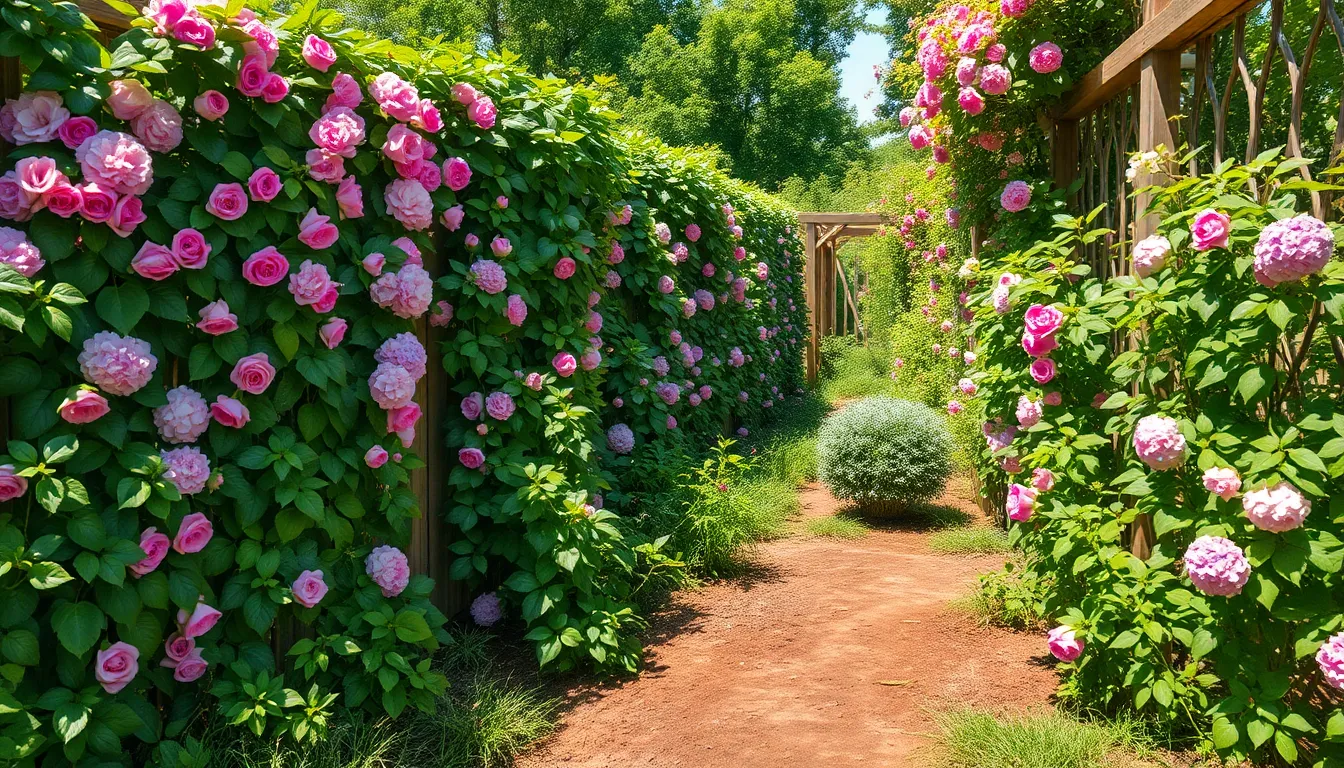
Creating the perfect environment for climbing vines ensures they’ll thrive and provide the stunning coverage you’re seeking. We’ll explore the essential factors that determine your vines’ success in your outdoor space.
Soil Preparation and Drainage Requirements
Well-draining soil forms the foundation for healthy climbing vine growth. Most vines prefer moist but well-draining soil that’s rich in organic matter to support their vigorous growth patterns. We recommend preparing your planting site with good soil drainage to prevent root rot and other moisture-related issues that can damage your investment.
Adding compost or organic matter to sandy or clay soils improves both fertility and drainage. This simple step creates the ideal growing medium that allows roots to breathe while retaining necessary moisture. Regular watering becomes especially important during dry spells to support healthy growth and abundant flowering throughout the growing season.
Sunlight and Shade Considerations
Full sun exposure of 6+ hours daily suits heat-loving and flower-loving vines like climbing roses and coral vine. This level of sunlight enables abundant blooms and fruit production that make these vines so desirable. Many flowering and fruiting vines require this optimal light exposure for peak performance.
Partial shade works well for many vine species and some even tolerate afternoon shade in hot climates. This flexibility allows you to plant vines in various locations throughout your garden. Light shade or dappled shade supports shade-tolerant species such as climbing hydrangea that can thrive with less direct sunlight.
Matching vine species to your site’s light conditions produces the best results. Insufficient sun exposure typically limits flower and fruit production, reducing the visual impact you’re trying to achieve. We recommend evaluating your space’s sun patterns before selecting your vine varieties.
Spacing Guidelines for Healthy Growth
Providing ample space for vines to climb and spread prevents overcrowding while promoting essential airflow. Proper spacing allows each plant to reach its full potential without competing for resources or creating dense, unhealthy growth patterns.
Typical mature vine sizes range from 10 to 30 feet tall and 3 to 20 feet wide depending on the species. Your spacing decisions should accommodate their mature growth width to prevent future problems. Trellises, fences, or pergolas need sizing to support these mature vine dimensions while allowing full sun exposure.
Fruiting vines may require both male and female plants for successful pollination and fruit set. We suggest researching your chosen varieties to determine if you’ll need multiple plants for optimal fruit production. This planning step ensures you’ll enjoy the harvest you’re expecting from your climbing vine investment.
Maintain Your Outdoor Climbing Vine Plants
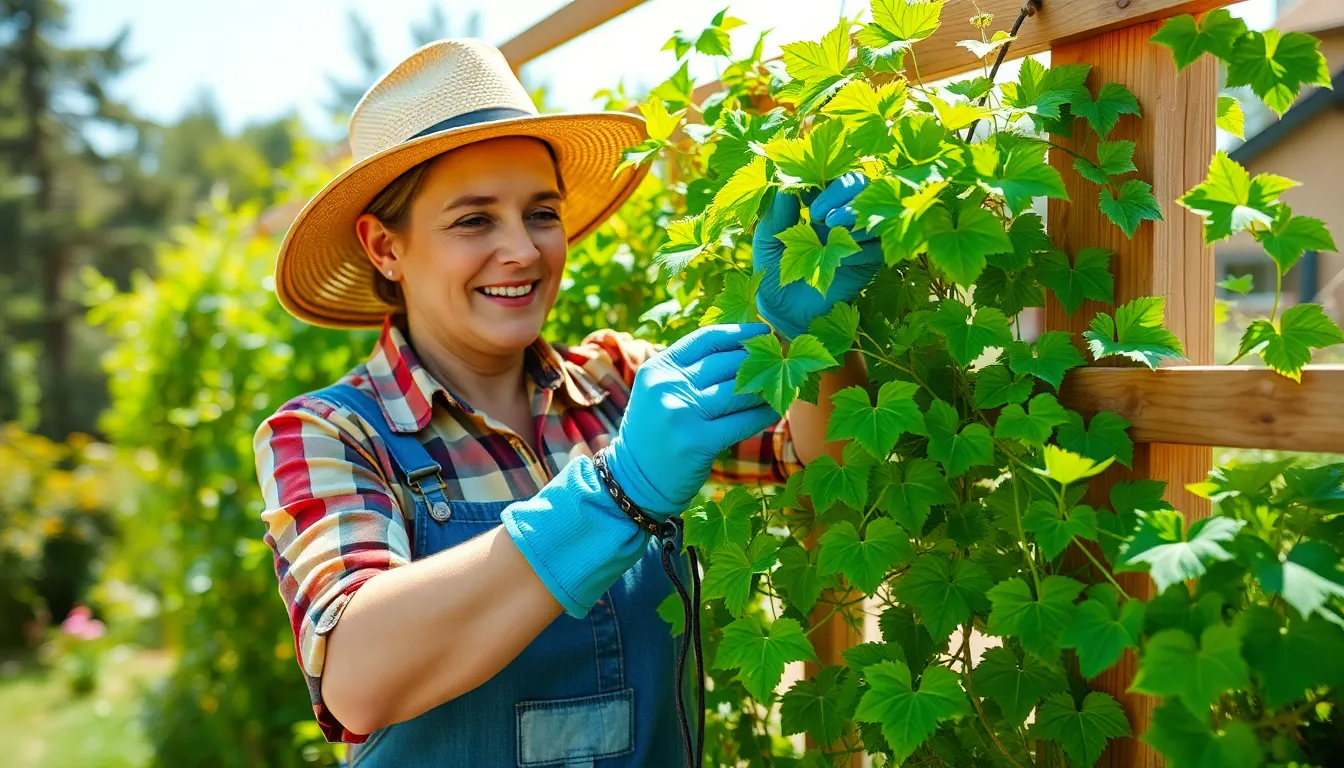
Proper maintenance keeps your climbing vines healthy and attractive throughout the growing season. Regular care ensures vigorous growth and abundant blooms while preventing common problems.
Pruning Techniques for Shape and Health
Remove dead, damaged, or diseased stems regularly to maintain plant health and encourage new growth. Perennial vines benefit from yearly pruning sessions that promote better blooming and create a tidy appearance. Tangled or unhealthy stems should be cut back even on vines that don’t require annual pruning.
Control shape and size through strategic pruning cuts that direct growth where you want it. Dead heading spent flowers encourages continued blooming throughout the season. Winter pruning works best for most perennial varieties when plants are dormant.
Focus on air circulation by thinning overcrowded areas to prevent fungal diseases. Opening up dense growth allows sunlight to reach inner stems and reduces moisture buildup. Proper pruning also makes it easier to inspect plants for pest problems.
Watering and Fertilizing Schedules
Maintain consistent moisture through regular watering, especially during dry spells when vines need extra hydration for healthy growth and flowering. Well draining soil prevents root rot while keeping roots adequately hydrated. Plant vines 11 to 17 inches away from their support structure base to ensure water reaches the roots effectively.
Apply balanced fertilizer during the active growing season to encourage lush foliage and abundant blooms. Spring feeding gives vines the nutrients they need for vigorous early growth. Monthly applications throughout summer support continuous flowering and healthy development.
Monitor soil conditions regularly to adjust watering frequency based on weather and soil drainage. Deep, infrequent watering encourages stronger root systems than frequent shallow watering. Mulching around the base helps retain moisture and regulate soil temperature.
Pest and Disease Prevention Methods
Inspect vines regularly for signs of pests, diseases, or other problems that could damage plant health. Early detection allows for prompt treatment before issues become severe. Remove diseased parts immediately to prevent spread to healthy sections of the plant.
Ensure good air circulation around plants by proper spacing and pruning to reduce fungal infections. Avoid overwatering which creates conditions that favor disease development. Training vines properly on supports prevents overcrowding that can harbor pests and diseases.
Improve sunlight exposure through strategic placement and pruning to strengthen plant immunity. Healthy, vigorous plants resist pest and disease problems better than stressed ones. Check periodically during the growing season to redirect growth and maintain proper support structure spacing.
Train Vine Plants for Desired Climbing Patterns
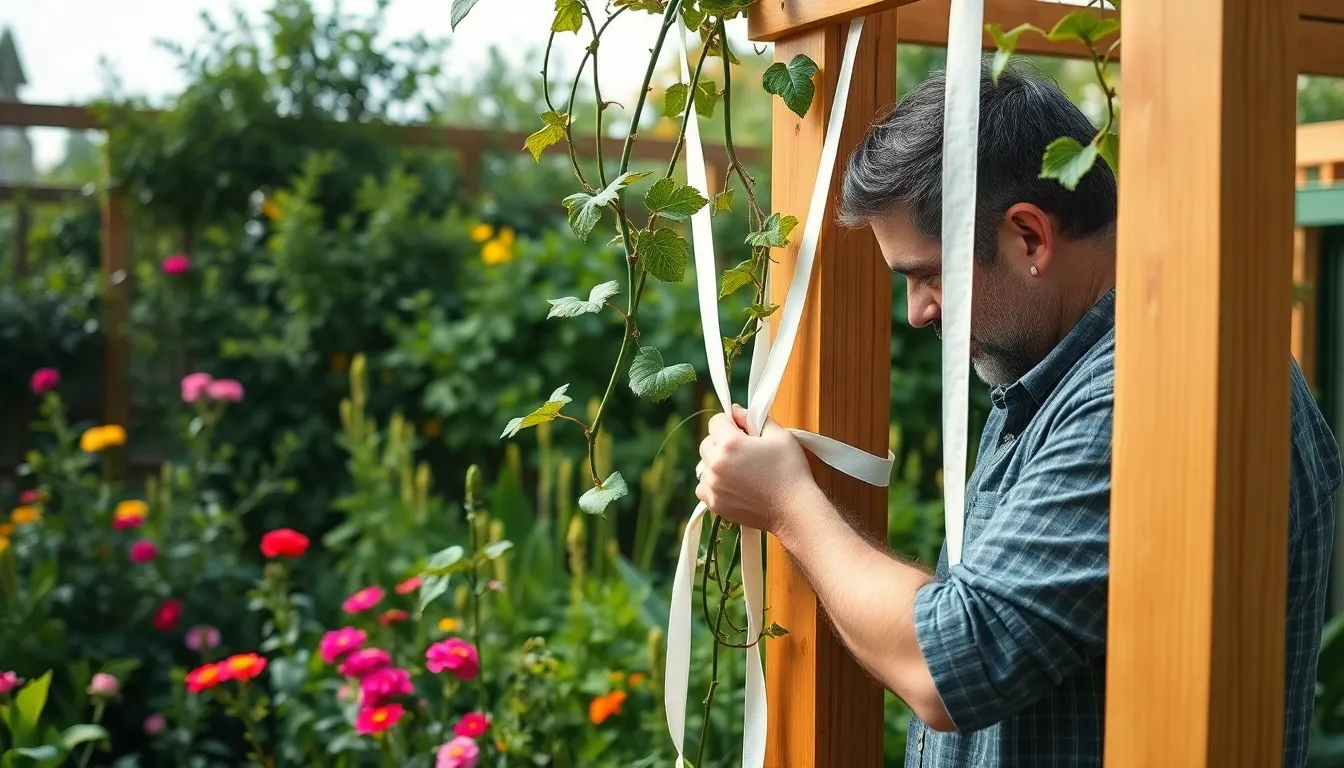
Training your climbing vines ensures they develop the exact growth pattern you envision for your outdoor space. We’ll guide you through proven techniques that direct growth energy precisely where you want it.
Directing Growth Along Support Structures
Secure vine shoots to trellis wires as they develop to establish proper climbing paths and prevent random spreading. We recommend tying new growth loosely with soft materials like plant ties or strips of fabric to avoid damaging tender stems.
Position horizontal and vertical support elements strategically to create a framework that guides natural climbing behavior. Trellises work best when they provide multiple contact points for tendrils and twining stems to grab onto during active growth periods.
Monitor shoot development weekly during the growing season to catch wayward branches before they establish unwanted patterns. We find that gentle redirection works better than aggressive pruning when vines are actively climbing and establishing their preferred routes.
Maintain proper spacing between support wires to allow adequate air circulation while giving vines sufficient attachment points. Most climbing varieties perform best with horizontal supports placed 12 to 18 inches apart depending on the vine’s mature size and growth habit.
Encouraging Horizontal Spread
Establish cordons along trellis wires by training young shoots to grow laterally rather than reaching straight upward. We create these horizontal arms by gently bending flexible shoots and securing them to wire supports with loose ties.
Prune back vertical growth once the main trunk reaches your desired height to redirect energy into horizontal branch development. Training methods like the Geneva double curtain system maximize fruit production by creating extensive horizontal growing surfaces.
Guide fruiting shoots outward from the main cordons to develop productive side branches that spread along your support structure. We’ve found that horizontal training significantly improves harvest accessibility and overall vine productivity.
Balance trunk development with arm extension during the first two growing seasons to create a strong foundation for long term growth. Smart pruning techniques help establish the horizontal framework that will support years of healthy vine development.
Managing Aggressive Climbing Varieties
Cut back excessive shoots regularly to prevent vigorous vines from overwhelming their support structures or neighboring plants. We recommend pruning aggressive varieties at least twice during the growing season to maintain desired size and shape.
Select the strongest single shoot to become your main trunk while removing competing growth that diverts energy from primary development. This focused approach helps control overly enthusiastic climbers that might otherwise spread beyond their intended boundaries.
Allow initial bushy growth in colder regions before selecting your main trunk, as this helps establish robust root systems that support controlled future growth. We find this technique particularly effective for varieties that show extreme vigor in their first season.
Carry out early season pruning to maintain structural control over varieties known for rapid spreading behavior. Regular maintenance prevents these enthusiastic climbers from damaging nearby structures or overwhelming smaller plants in your garden design.
Design Stunning Vertical Gardens with Climbing Vines
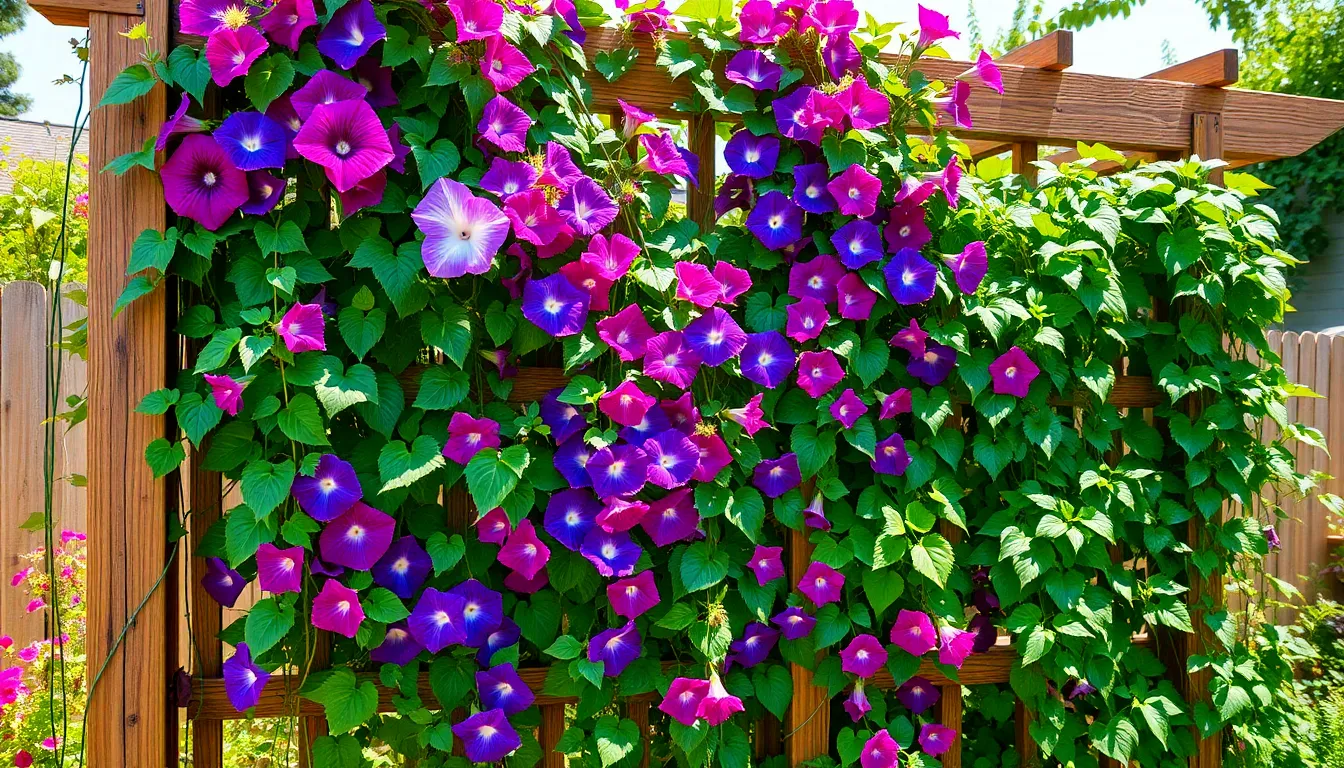
Vertical gardens transform ordinary walls and fences into living masterpieces that maximize our garden space while creating stunning focal points. We can achieve dramatic height and visual impact by selecting the right climbing vines for our exact design goals.
Creating Privacy Screens with Dense Vines
Dense climbing vines provide instant privacy answers that block unwanted views while adding natural beauty to our outdoor spaces. Fast-growing varieties like Virginia Creeper and Boston Ivy can quickly cover trellises or fences, creating effective barriers that reduce noise and provide year-round screening. Woody climbers such as grapevines work exceptionally well on pergolas, forming intimate shaded areas that blend utility with aesthetic appeal.
Evergreen climbing varieties offer consistent privacy throughout all seasons, maintaining their coverage even during winter months. We’ll find that thick-leaved vines create the most effective screens, with their overlapping foliage forming dense walls of green. Strategic placement of these privacy screens can define outdoor rooms and create secluded spaces for relaxation and entertainment.
Adding Color and Texture to Walls and Fences
Flowering vines transform bare vertical surfaces into vibrant displays that change with the seasons. Clematis varieties bring spectacular blooms in purple, pink, white, and red, with around 300 species available to match our color preferences. Morning glories unfurl their trumpet-shaped flowers each day, creating waves of blue, purple, and white that cascade down walls and fences.
Textural variety comes from mixing different leaf shapes and growth patterns throughout our vertical gardens. Vines with heart-shaped leaves like morning glories contrast beautifully with the delicate, compound foliage of clematis or sweet peas. We can create visual depth by allowing some vines to cascade freely while training others to follow exact patterns on their supports.
Different growth habits add unexpected elements to our wall and fence designs. Some vines scramble and twist naturally, while others maintain more structured growth patterns that complement formal garden styles.
Combining Different Vine Varieties for Visual Interest
Mixing multiple vine species creates ever-changing vertical gardens that offer year-round interest and seasonal variety. We can combine early-blooming clematis with late-season flowering varieties to extend the color display from spring through fall. Evergreen vines paired with deciduous flowering types provide consistent structure while adding seasonal bursts of color and texture.
Edible climbing vines like grapes, cucumbers, and pole beans add functional beauty to our vertical gardens. These productive climbers can be woven among ornamental varieties, creating gardens that feed both the body and the soul. Height variation becomes crucial when combining different species, with vigorous growers like Virginia Creeper serving as backdrop plants for more delicate flowering vines.
Bloom timing coordination ensures continuous color throughout the growing season. Early spring clematis can be paired with summer-blooming honeysuckle and fall-flowering sweet autumn clematis for extended seasonal interest. We’ll achieve the most dramatic effects by selecting vines with contrasting foliage colors, such as deep green Boston Ivy with variegated climbing hydrangea.
Conclusion
We’ve covered everything you need to create stunning vertical gardens with outdoor climbing vines. From fast-growing annuals that provide instant coverage to perennial varieties that’ll reward you for years to come these plants offer endless possibilities for transforming your outdoor space.
The key to success lies in matching the right vine to your exact conditions and providing proper support structures. Whether you’re looking to create privacy screens enhance bare walls or add fragrant blooms to your garden there’s a climbing vine that’ll meet your needs.
With the right care and training techniques your climbing vines will flourish and create the beautiful natural sanctuary you’ve been dreaming of. Start planning your vertical garden today and watch your outdoor space transform into something truly spectacular.
Frequently Asked Questions
What are the main benefits of using climbing vines in outdoor spaces?
Climbing vines create natural privacy screens, transform unsightly walls and fences into beautiful green backdrops, and provide natural cooling during hot months. They maximize vertical space while adding visual appeal to gardens and outdoor areas.
Which annual climbing vines grow the fastest?
Morning glories can reach 6-10 feet in a single season, while sweet peas and nasturtiums also provide quick coverage. These annual vines are perfect for immediate results and seasonal color in your garden.
What are the best perennial climbing vines for long-term coverage?
Clematis offers stunning flowers with 300+ species to choose from, honeysuckle provides fragrant blooms and attracts wildlife, and Virginia Creeper delivers rapid coverage with excellent adaptability to various growing conditions.
What support structures work best for climbing vines?
Trellises and arbors work well for decorative purposes, wire mesh and fencing suit larger areas, while pergolas and gazebos can support heavy vine growth. Choose structures based on your vine’s weight and growth habits.
What growing conditions do climbing vines need?
Most climbing vines require well-draining soil rich in organic matter, full sun exposure for flowering varieties, and proper spacing for airflow. Regular watering and compost amendments promote healthy growth.
How often should I prune climbing vines?
Prune climbing vines regularly to remove dead stems, control shape, and promote blooming. Timing depends on the variety, but most benefit from annual pruning during dormant seasons.
Can climbing vines provide privacy year-round?
Yes, evergreen climbing varieties like some ivy species maintain foliage throughout all seasons. For consistent privacy, choose evergreen options or plant dense deciduous varieties that create thick coverage.
How do I train climbing vines to grow in specific directions?
Secure vine shoots to support structures, guide growth horizontally for better fruit production, and regularly monitor development. Use ties or clips to direct vines along desired paths.







